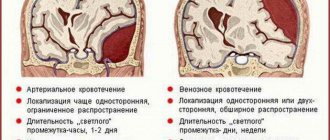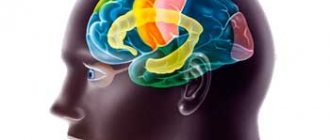Sensitive ataxia - a nervous disease comes from the Greek word “ataxia” - “disorder”, because a person’s balance in an upright position is disturbed, and the coordination of movements is completely or partially upset.
To understand how the disease develops, it is necessary to understand how coordination control works in the human body.
Our body has primary receptors - peripheral ones, which are located in the joints, muscles and canals of the inner ear.
They collect information about the position of the human body in space. This information is then carried along the spinal cord to the vestibular nuclei in the brain stem.
The cerebellum is the primary organ that is involved in regulating a person’s position in space. Thus, when the pathways through the posterior columns of the spinal cord are damaged, sensitive ataxia develops.
A disorder in which a person loses the ability to communicate normally - motor aphasia. Details in the article. Shy-Drager syndrome is a severe incurable disease in which death occurs within 5-7 years. Methods for diagnosing and alleviating the patient’s condition.
Why does the disease manifest itself?
The sensitive form of ataxia develops in the event of loss of receptors or sensory channels of muscles and joints in any area - in the roots of the posterior part, in the peripheral nerves, in the posterior columns of the spinal cord, in the internal capsule or in the brain stem. The disease manifests itself with tabes in the spinal cord, polyneuritis, etc.
With sensitive ataxia, a disorder in the clarity of movements occurs. To identify it, a deep sensitivity test is carried out, a heel-knee test is taken with open and closed eyes. The patient is characterized by a gait disorder - the person begins to spread his legs wide, bending them unevenly and hitting the heel hard on the ground or floor. As vision deteriorates, the symptoms of ataxia increase sharply. And when visual control is turned on, the symptoms, on the contrary, subside. All this is complemented by a violation of deep sensitivity. It is also not common for patients to develop tremor.
At times, defects in posture fixation develop, for example, when visual control is turned off in a person who holds his hands horizontally, there is a slow shift of the hands in different directions and involuntary manipulations in the fingers and hands. Holding the limbs in extreme poses of extension and flexion is much easier compared to the middle poses.
It is important!
The sensitive form of ataxia with isolated disconnection of the spinocerebellar pathways develops very rarely and is not complemented by disorders of deep sensitivity, because these pathways are directly related to the implementation of signals projected into the postcentral gyrus and creating a feeling of fixation of the position and movement of the limbs.
The disease affects the channels of deep sensitivity located in the brain stem and in the thalamus on the side opposite to the area of localization of the affected lesion. In the area of crossing of the medial loop, pathology can damage both sides at once.
Diagnostic studies
In the study of sensitive ataxia, a special role is given to the following tests:
- Finger-nasal, in the case of ataxia, is characterized by the appearance of a miss. The patient cannot get into his own nose;
- Finger hammer - an analogue of the previous test, except that the patient does not hit the doctor’s neurological hammer;
- The heel-knee exercise is performed in a supine position with legs extended. The doctor asks the patient to touch the knee of the other with the heel of one leg. And then “go down” to the foot along the front surface of the shin. Patients with ataxia cannot hit their knee with their heel or slide smoothly along their leg. Their movements are intermittent and crooked;
- Test for adiadochokinesis, which reveals the inability to perform alternating, rapid movements;
- Romberg's test, which reveals instability in the patient's standing position with his arms extended forward.
In addition to samples, the following are used as additional diagnostic methods:
- EEG – electroencephalography;
- MRI – magnetic resonance imaging;
- EMG – electromyography.
Carrying out disease detection
In order to establish the development of pathology, it is necessary to take tests for the diagnosis of asymmetry, tests of flexion and extension of the fingers. In addition, a walking and standing test is required. Patients should perform these tests both with their eyes closed and with their eyes open.
How to properly carry out treatment and preventive measures
It is impossible to carry out on your own; you must visit a neurologist. In this case, the neurologist identifies the main symptoms and causes of the disease. Treatment usually involves eliminating symptoms and requires taking B vitamins, immunoglobulins, and riboflavin. A course of therapeutic exercises is also conducted. The doctor develops an individual approach to each patient. When a hereditary type of pathology manifests itself, the treatment process is complicated and often the symptoms do not leave the patient for a long time.
Prophylaxis of ataxia itself becomes impossible. Before carrying out these activities, it will be necessary to implement the prevention of acute forms of infectious pathologies - otitis media, pneumonia, sinusitis, etc., which can cause sensitive ataxia.
It is necessary to avoid consanguineous marriages and be sure to remember that hereditary forms of sensitive ataxia are almost always passed on to the child, and therefore patients are advised to refuse to have children, and, if desired, to adopt another child.
Vestibular ataxia is a type of ataxia that results in dysfunction of the vestibular system. The vestibular system consists of the inner ear canals, which contain fluid.
They sense head movements and help with balance and spatial orientation. Vestibular ataxia is a consequence of a disorder of the inner ear.
Signals from the inner ear are unable to reach the cerebellum and brain stem when a person has vestibular ataxia. A person with vestibular ataxia experiences a loss of balance while maintaining strength. The patient often experiences dizziness, a feeling that everything around is spinning. Shows loss of balance or involuntary eye movement.
In unilateral or acute cases, the anomaly is asymmetrical, the patient experiences nausea, vomiting, and dizziness. In slow chronic bilateral cases it is symmetrical, the person only feels an imbalance or instability.
There are many types of ataxia. In this article, we will discuss some of the most common types, causes, and available treatments.
Fast Facts
Ataxia is caused by a wide range of factors.
- Symptoms include poor coordination, slurred speech, tremors, and hearing problems.
- Diagnosis is complex and often requires a series of studies.
- It is not always curable, but symptoms can often be relieved.
It belongs to a group of disorders that affect coordination, speech, and balance. Makes it difficult to swallow and walk.
Some people are born with it, others develop the syndrome slowly over time. For some, it is the result of another condition, such as stroke, multiple sclerosis, brain tumor, head injury, or .
It gets worse or stabilizes over time. It partly depends on the cause.
Causes
There are a large number of causes of ataxia. Most often it is associated with neurological pathologies. List of diseases leading to ataxia:
- Traumatic brain injuries, tumor formations.
- Cerebral circulation disorders.
- Accumulation of cerebrospinal fluid in the ventricles - hydrocephalus.
- Demyelinating pathologies of the central nervous system.
- Inflammatory diseases and tumors of the inner ear.
- Infectious lesions of the brain.
In addition, ataxia can be a consequence of a deficiency of B vitamins, alcohol abuse, hereditary diseases, and various intoxications. In old age, the syndrome is often a manifestation of the natural aging process and degenerative changes in the brain.
Types
The following are some of the most common types of ataxia:
Cerebellar ataxia
The cerebellum is responsible for sensory perception, coordination and motor control.
Caused by dysfunction of the cerebellum, an area of the brain involved in the assimilation of sensory perception, coordination and motor control.
Cerebellar ataxia provokes neurological problems such as:
- lethargy;
- lack of coordination between organs, muscles, limbs, joints;
- weakened ability to control distance, power, speed of movement of arms, legs, eyes;
- it is difficult to estimate exactly how much time has passed;
- inability to perform fast, alternating movements;
The extent of symptoms depends on which parts of the cerebellum are damaged, and whether there is damage on one side (unilateral) or on both sides (bilateral).
If the vestibular system is affected, balance control of the face and eyes will be impaired. The person stands with their feet wide apart to gain better balance and avoid rocking back and forth.
Even when the patient's eyes are open, balance when bringing the legs together is difficult.
If the cerebellum is affected, the patient will have an unusual gait with uneven steps, and stuttering begins and stops. Spinocerebellum regulates body position and limb movement.
If the deep structures of the brain are affected, the person will have problems with voluntary movements. The head, eyes, limbs, and torso may tremble when walking. Speech is slurred, with changes in rhythm and volume.
Sensory ataxia
Appears due to loss of proprioception. Proprioception is the sense of the relative position of neighboring parts of the body. Indicates whether the body is moving with the required force and provides feedback regarding the position of its parts relative to each other.
A patient with sensory ataxia typically has an unsteady stomping gait, with the heel striking hard as it hits the ground with each step. Postural instability worsens in low light conditions.
If the doctor asks you to stand with your eyes closed and your feet together, the instability will get worse. This is because the loss of proprioception makes a person much more dependent on visual input.
It is difficult for him to perform smoothly coordinated movements of the limbs, torso, pharynx, larynx, and eyes.
Cerebral ataxias
Early onset cerebellar ataxia usually occurs between the ages of 4 and 26 years. Late appears after the patient has reached 20. Late is characterized by less severe symptoms compared to early.
Acute impairment of motor coordination may be caused by damage to the cerebellum or its connections in the trunk (cerebellar ataxia), nerve fibers carrying deep sensitivity (sensitive ataxia), the vestibular system (vestibular ataxia), the frontal lobes and related subcortical structures (frontal ataxia). It can also be a manifestation of hysteria. Acute cerebellar ataxia is manifested by impaired balance, walking and coordination of movements in the limbs. Damage to the median structures of the cerebellum is accompanied by nystagmus, dysarthria of the type of scanned speech (slow monotonous speech interrupted by stress on each syllable), tremor of the trunk and head, imbalance in the Romberg test, a characteristic change in walking (on legs wide apart with the body swaying from side to side ). Damage to the cerebellar hemispheres causes hemiataxia on the affected side with impaired precision of movements (dysmetria, accompanied by missed hits) and intention tremor (occurring in the final stage of purposeful movement), which are detected during the finger-nose and knee-heel tests. At the same time, muscle hypotonia and decreased tendon reflexes are often detected.
Etiology.
The cause of acute cerebellar ataxia can be various pathological conditions, most often:
- Intoxication with drugs - lithium drugs, antiepileptic drugs (diphenine, barbiturates, carbamazepine, ethosuximide), benzodiazepines; toxic substances (mercury, organic solvents, synthetic glue, gasoline, cytostatics). Ataxia is often accompanied by drowsiness or confusion.
- Cerebellar, early recognition of which can save the patient’s life. Cerebellar infarction occurs as a result of thrombosis or embolism of the cerebellar arteries arising from the vertebral or basilar artery. It is manifested by hemiataxia and muscle hypotonia on the affected side, headache, dizziness, nystagmus, dysarthria and signs of concomitant damage to the trunk - limited mobility of the eyeballs, weakness of the facial muscles or impaired facial sensitivity on the affected side, sometimes hemiparesis or hemihypesthesia on the opposite side. As a result of rapidly growing edema, compression of the trunk with the development of coma and herniation of the cerebellar tonsils into the foramen magnum are possible, with a fatal outcome that can only be prevented by surgical intervention. It should be taken into account that cerebellar hemiataxia may be a manifestation of a more favorably developing infarction of the medulla oblongata, which also causes Horner's syndrome (miosis, drooping of the upper eyelid), decreased sensitivity on the face, paresis of the muscles of the larynx and pharynx on the affected side, and impaired pain and temperature sensitivity according to the hemitype on the opposite side (Wallenberg-Zakharchenko syndrome). Hemorrhage into the cerebellum is often caused by arterial hypertension and is manifested by sudden intense headache, vomiting, dizziness, and ataxia. Rigidity of the neck muscles, nystagmus, and sometimes limited movement of the eyeballs towards the affected side, inhibition of the corneal reflex and paresis of the facial muscles on the affected side appear. Depression of consciousness rapidly increases with the development of coma. As a result of compression of the trunk, increased tone in the legs and pathological foot signs occur. In some cases, death can only be prevented by surgical intervention (hematoma evacuation).
- Infectious or post-infectious diseases. Cerebellar ataxia can be a manifestation of viral, acute disseminated encephalomyelitis, or cerebellar abscess. In children, after a viral infection (especially often after), acute cerebellar ataxia may develop, mainly manifested by disturbances in static movement and walking. This condition is referred to as acute cerebellitis and usually results in complete recovery within a few weeks or months.
- Acute Wernicke encephalopathy is manifested by a triad of symptoms - ataxia, ophthalmoplegia, confusion or depression - and is associated with vitamin B deficiency, most often caused by alcoholism.
The cause of subacutely developing cerebellar ataxia can be tumors, including metastatic ones, subdural hematoma.
Clinic.
Acute vestibular ataxia
usually accompanied by rotational dizziness, lightheadedness, nausea or vomiting, nystagmus, and sometimes hearing loss. The severity of ataxia increases with changes in the position of the head and torso, and rotation of the eyes. Patients avoid sudden head movements and carefully change body position. In some cases, there is a tendency to fall towards the affected labyrinth. Coordination in the hands does not suffer. The cause of acute vestibular ataxia is most often peripheral vestibulopathy (see Dizziness), less often brainstem stroke or basilar.
Acute sensitive ataxia,
accompanying a violation of joint-muscular and vibration sensitivity, occurs with acute sensory polyneuropathy of post-infectious, paraneoplastic or toxic origin, less often with compression or inflammatory damage to the spinal cord. Sensitive ataxia is characterized by a sharp increase in instability when vision control is turned off (eyes are closed). Balance and walking disorders can occur suddenly in patients with arterial hypertension with ischemic damage to the basal ganglia, thalamus, upper brainstem, and sometimes with bilateral damage to the frontal lobes. Such patients can actively move their legs while lying down. But when standing up, they cannot take at least one step without support or stay on their feet. Anamnestic information (long-term arterial hypertension), revitalization of tendon reflexes from the legs, paratonia (active resistance to passive movements), grasping reflexes facilitate the diagnosis in such cases. Walking disturbances are one of the classic manifestations of hysteria. The psychogenic nature of the symptoms may be supported by their variability, dependence on the situation, and a bizarre gait, which is not similar to the usual variants of ataxia and rather demonstrates the patient’s ability to balance perfectly on the verge of falling, rather than an imbalance. Hysterical symptoms rarely occur in isolation - they are usually combined with each other or replace each other. In a patient, for example, along with ataxia, pseudoparesis, mutism, and a functional type of sensitivity disorder can be detected. The presence of demonstrative personality traits and “beautiful indifference” are also characteristic.
(from the Greek ταξία - order, ἀταξία - lack of order, disorder) is a term that is used to describe poorly coordinated, awkward, disorganized movements that are not associated with disorders of muscle tone (spasticity, paresis, etc.). They include (but are not limited to): impaired coordination of movements, excessive or insufficient amplitude of purposeful movements (dysmetria), awkwardness when performing rapid alternating movements (dysdiadochokinesis, adiadochokinesis), involuntary stops of movements (hypometria), tremor.
may result from damage to the cerebellum (cerebellar ataxia) or dorsal funiculi of the spinal cord (sensory ataxia) or dysfunction of the vestibular system (vestibular ataxia). In patients with multiple sclerosis, the listed types of ataxia can occur either alone or in combination.
According to research results, it is believed that up to 32% of people with multiple sclerosis at different periods of the disease experience symptoms of ataxia. The severity of this symptom in multiple sclerosis varies widely, from mild balance problems that require only greater caution when moving, to the inability to stand or walk without assistance. Ataxia is often accompanied by other symptoms of MS, such as weakness, spasticity, and sensory or visual disturbances.
Video
Sensitive ataxia (sensitive) occurs when receptors or pathways of joint-muscular sensitivity are lost in any area: in peripheral nerves, dorsal roots, dorsal cords (columns) of the spinal cord, brain stem or internal capsule. The clarity of movements is upset. It is checked by studying deep sensitivity, finger-to-nose and heel-knee tests, standing in the Romberg position with open and especially with closed eyes. An ataxic gait is observed, especially characteristic of Gaulle's bundle lesions (posterior columnar ataxia): the patient spreads his legs widely, disproportionately bending and unbending them, striking the heel hard on the floor (“stamping”, “tabetic” gait). Turning off vision in these cases sharply increases ataxia . Sensitive ataxia is observed in polyneuritis, funicular myelosis, tabes spinal cord, and Friedreich's familial ataxia.
Cerebellar ataxia depends on dysfunction of the organ of coordination of movements and its connections with other parts of the nervous system. She retains a deep muscular feeling; All coordination tests are impaired, but closing the eyes does not impair their performance. A characteristic sign of the disease is adiadochokinesis (the inability to quickly change one movement to the opposite, for example, a rapid change in pronation and supination of the hand), dysmetria (or rather, hypermetria, i.e., an increase in the range of movement). Asynergy (loss of coordination between muscle contractions) is also common: for example, when bending the body back, synergistic bending of the legs at the knee joints does not occur and the patient falls; when trying to sit up from a lying position without the help of hands, the legs are lifted up - Babinsky asynergia. This type of ataxia is accompanied by a decrease in muscle tone, intentional (from the Latin intendo - strain) trembling (tremor increases sharply during actions that require precision, for example, when a finger hits the nose, the examiner’s finger, when bringing a spoon to the mouth, etc.) , scanned speech (“chopped” speech, syllable by syllable). Damage to the cerebellar hemispheres leads to the development of ataxia of the homolateral limbs, while damage to the cerebellar vermis leads to ataxia of the trunk. Cerebellar ataxia is observed with tumors and acute inflammatory diseases of the cerebellum, hemorrhages, damage to the cerebellar peduncles, often with multiple sclerosis. If there is a sudden loss of coordination, it becomes impossible to walk, stand and sit.
Vestibular ataxia develops when the vestibular apparatus is damaged and is static in nature. In this case, there are no signs of disturbances in proprioceptive sensitivity and cerebellar functions, but there are vestibular symptoms - dizziness of a systemic nature and increased excitability of the vestibular apparatus to special loads. When trying to study in the Romberg position, the patient loses his balance and always falls in a certain direction. The disease occurs when the inner ear or vestibular nuclei and pathways are damaged by various processes.
It develops as a result of damage to the channels of deep sensitivity of muscles and joints, mainly due to damage to the posterior cords of the spinal cord, in rare cases - with disease of the peripheral nerves located in the posterior part of the spinal roots, the medial lemniscus in the brain stem and the thalamus.
It is important!
This form of ataxia can be detected in a patient with a clear impairment of deep sensitivity and a noticeable increase in the manifestation of pathology when closing the eyes. Sometimes in this situation it is necessary to note the formation of a sign of impaired movement of the affected limb.
Symptoms of cerebellar ataxia
The cerebellum is responsible for the coordination of voluntary muscle movements. Damage to the cerebellum can lead to characteristic changes in gait: the patient walks with his legs widely spaced; loses balance when changing posture (for example, when trying to get up from a chair).
With cerebellar ataxia, it is difficult for the patient to make purposeful movements (for example, touching a point with a finger); tremor, nystagmus, and dysarthria (speech disturbances) often occur. Gait and speech with cerebellar ataxia resemble the gait and speech of a drunk person.
Symptoms of sensory ataxia
Sensory ataxia results from damage to the pathways that transmit proprioceptive information (that is, information about the position of body parts relative to each other). A characteristic sign of sensory ataxia is loss of balance when closing the eyes (for example, in the Romberg position) or in the dark. Often with this type of ataxia, vibration sensitivity is impaired.
The gait with sensory ataxia resembles the gait with cerebellar ataxia: the patient spreads his legs wide, but at the same time falls when closing his eyes and in the dark.
Treatment of ataxia
To date, unfortunately, there is no specific treatment for ataxia. In the case of multiple sclerosis, if the appearance of symptoms of ataxia is associated with an exacerbation of the disease, their partial or complete regression can be expected after the exacerbation has stopped. If, after treatment of an exacerbation, residual neurological symptoms persist, then the following can alleviate the patient’s condition and help him adapt:
- physiotherapy,
- classes with a speech therapist,
- in some cases, the use of a cane or walker.
Diagnostics
Symptoms of ataxia
Ataxia - what it is is unknown to many, therefore, in order to completely determine the cause of ataxia, it is necessary to undergo a series of examinations using special equipment.
The patient must undergo an MRI to identify pathologies of the cerebral cortex.
Specialists conduct testing of each part of the nervous system.
DNA tests and family history are carried out, as the disease may be genetic.










